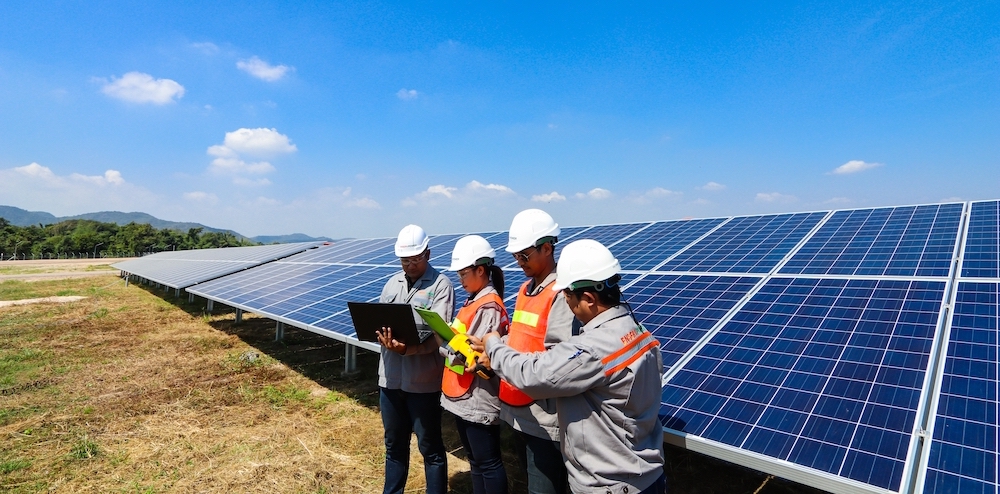
FAST, RELIABLE POWER SWITCHING KEY TO FEASIBLE GREEN ENERGY
The push for moving to renewable energy sources intensifies each year. Governments, businesses, and the public all seem to agree that it is time to leave fossil fuels behind and move into a new era powered by clean energy. Accel-RF stands ready to help accomplish this goal by providing reliability testing solutions for the new generation of electronic power devices that can help make clean energy a reality.

STUCK ON FOSSIL FUEL
After decades of talk and billions of dollars of investment, why hasn’t it happened yet?
The reason the world still depends primarily on crude oil and coal to move its economies and energize its homes is efficiency. Despite its shortcomings, no renewable energy source can come close to providing the amount of power per dollar as fossil fuel.
Add to that the fact that the world has slowly built its entire energy infrastructure to work with the predictable way carbon-based energy sources produce power. It is not economically feasible to replace the whole power grid. Instead, the strategy must include adapting the variableness of naturally occurring energy sources to work with the transmission and delivery systems already in place.
The ability to squeeze more usable power from renewable sources has improved dramatically over the years. Better solar panel and windmill turbine designs, plus the willingness to upscale projects by sacrificing large tracts of acreage to energy farms, have resulted in increased efficiency and clean power utilization. But even with these improvements, green power doesn’t even come close to meeting modern society’s power demands.
SMART POWER CONDITIONING
To put renewable energy sources to work with enough capacity to compete with and eventually overcome fossil fuels, they must be tamed. Solar, wind, and hydropower all suffer from the fact that they are not consistent. Cloudy days lower the energy output for solar panels, storms with high winds can spike wind farm power production, and raging floods or droughts can adversely affect hydropower systems.

The bottom line is that Nature refuses to cooperate in providing steady, reliable power output, preconditioned to work with the existing structures. Getting power from renewable sources ready to use requires the help of power electronics.
The irregular waveform generated by wind turbine generators on large wind farms, for example, must be smoothed out before entering the power transmission system to ensure the stability of the grid.
Microcontrollers operate AC/DC converters daisy-chained with DC/AC converters to condition the power to the correct frequency, voltage and harmonics before injecting it into transmission lines.
A similar process occurs with solar farms. The only difference is that solar panels generate DC that has to be rectified and conditioned to enter the grid. On smaller-scale solar installations, power electronics regulate the charging and usage of power stored in battery banks to help ensure efficiency and safe operation.
These and other interventions are necessary to integrate renewable energy into the existing structure. However, the problem of power losses at each control point further reduces efficiency. Reliance on silicon-based power switching technology results in losing many of the gains realized from using better materials and designs in renewable power production.
GAN SEMICONDUCTORS IN POWER ELECTRONICS
GaN (Gallium Nitride) is helping overcome many of the limitations of silicon devices across many electronics industry segments. GaN-based switching devices are significantly faster than their silicon counterparts. GaN devices have better efficiency, power density, and reduced size compared to silicon chips. The result is that the supporting circuitry for inductance and capacitance is smaller, making it a lighter, more compact package.
GaN transistors boast the ability to support switching frequencies about ten times higher than those of silicon products. They can also operate at much higher voltages and currents. These characteristics make them suitable for all Power Electronics applications and position them as the game-changer for making widespread adoption of renewable energy possible.
GaN technology is the answer to help designers overcome the hurdles and create efficient energy conversion and storage systems needed to make green energy a viable commodity.
IMPORTANT RELIABILITY PARAMETERS OF CONCERN
DC Bias Current
Active semiconductor components require a DC power supply to operate. The DC bias voltage and current levels are critical parameters as the power dissipation of each active element will contribute to temperature rise and drive overall efficiency.
Industries:
![]()
![]()
![]()
![]()
![]()
![]()
![]()
![]()
RF Output Power
The RF output power of an amplifier drives the overall capabilities of a transmitter. The saturation level and how the output power of a device compresses with input power is used to determine which applications and systems are suitable for that device.
Industries:
![]()
![]()
![]()
![]()
![]()
![]()
![]()
RF Gain
The ratio of RF power delivered to a load relative to the input power. How gain changes and compresses as these levels rise and approach saturation is critical to designing systems for any RF application.
Industries:
![]()
![]()
![]()
![]()
![]()
Ohmic Contact Resistance
In semiconductors, this is the intrinsic resistance through the metalized terminals of the device into the channel or junction. A physical change in the ohmic contacts, which can be an effect of metal migration, can change the resistance and impact the electrical performance of a device.
Industries:
![]()
![]()
Intermodulation Distortion
IMD occurs when two signals are present in a nonlinear system, such as an amplifier. The frequency harmonics of these two signals mix and create 2nd and 3rd order intermodulation products. Measuring and mitigating these distortion levels are critical for communication applications.
Industries:
![]()
![]()
![]()
![]()
Phase Noise
Commonly referred to as “jitter”, phase noise is the random fluctuations of the phase of a signal source. It is present in oscillators and digital clocks and can have detrimental effects on a system where frequency conversion takes place. A signal with high phase noise can end up occupying more of the spectrum than intended and introduce error.
Industries:
![]()
![]()
![]()
![]()
Noise Figure
This is a critical parameter in all Receiver designs. The Noise Figure must be low for a system to be sensitive enough to detect and process weak signals. Low Noise Amplifiers (LNA) are typically the first element in a receiver and are designed to minimize Noise Figure.
Industries:
![]()
![]()
![]()
![]()
![]()
Signal Linearity
For amplifiers in RF applications, this represents the relationship between the input power and the output power of a device. At low input power levels, linearity is uniformly quantified by the gain. As input drive increases, the device gain compresses as the device saturates and the linearity characteristics change.
Industries:
![]()
![]()
![]()
![]()
![]()
Switching Response Time
The rise and fall time of RF switches used in high-frequency applications can set limitations on the bandwidth and other key aspects of a system. When used in a phased array, the switching speed can limit how quickly the beam can be steered, for example.
Industries:
![]()
![]()
![]()
![]()
Frequency Stability
This represents the ability of a source, such as an oscillator, to maintain a constant frequency output. Outside influences such as temperature and change in bias voltage can lead to drift and affect frequency stability. Stability in communication systems is required so that a signal does not drift outside of its designated band.
Industries:
![]()
![]()
![]()
![]()
![]()
![]()
Many new and envisioned markets are just beginning to standardize and regulate system requirements in the renewables sector. For the market segments of solar, wind, geothermal, and hydropower the latest technology enabler lies in converting the energy to useable electricity. Conversion of energy from one resource to an existing transmission media, like the electric power grid, is where many new benefits will occur. This new market space must fit, for the foreseeable future, into an existing and long-standing distribution network. The distribution of electric power to homes and offices and indeed across the country has been built and will be in place for a long time. To completely replace this grid with a new infrastructure will take many years. However, for individual homes and some multi-user communities, a stand-alone closed system may be more rapidly put in place. Especially as renewable energy systems are realized as modular cascade-able building blocks. The reliability test drivers for the Renewable Energy Industry will need to test for the new technology and assure the existing standards of the highly regulated power industry.
The reliability test requirements are:
- Safety liabilities (risks) from failed components in the system.
- Performance consistency from unit to unit for effective deployment across a highly regulated market.
- Performance degradation with age would drive maintenance service costs and user dissatisfaction.
- Maintenance cost (down-time) leads to inefficient system utilization.
- System return-on-investment (ROI) plans are usually “long-life” expectations (>10 years of service).
ACCEL-RF FOR RELIABILITY
 The inevitable progress of renewable energy will largely depend on the capabilities provided by new semiconductor technologies like GaN. To ensure success is long-lasting, reliability testing and quality assurance will play a significant role in the development process. Since GaN devices are a recent addition to the electronics market, little testing data exist to prove they will work consistently in applications for delivering reliable, clean energy.
The inevitable progress of renewable energy will largely depend on the capabilities provided by new semiconductor technologies like GaN. To ensure success is long-lasting, reliability testing and quality assurance will play a significant role in the development process. Since GaN devices are a recent addition to the electronics market, little testing data exist to prove they will work consistently in applications for delivering reliable, clean energy.
Extensive burn-in testing is required to weed out faulty devices that occur due to the newness of GaN manufacturing processes. Testing can help speed up the process of implementing renewable energy systems and integrating them with existing infrastructure.
The Accel-RF Power-Switching System is ideally suited for helping to roll out the horde of sophisticated new GaN devices needed to make renewable energy a fully viable alternative.
The Accel-RF Power-Switching Test System can measure reliability for switching power applications up to 1kV (off) and 25A (on) at up to 1 MHz switching frequencies, giving manufacturers the flexibility to work within the needed ranges of devices related to Power Electronics. This system tests multiple devices at high temperatures in a small physical space for greater efficiency in the lab.
The inherent advantages of GaN show that it can be the disruptive technology needed to enable a new era focused on renewable energy-based infrastructure. The overall increase in system efficiency that GaN provides, coupled with improving technologies in solar and wind energy extraction could be the tipping point to start moving away from fossil fuel dependence. Any large-scale adoption of GaN-based systems into the energy grid will require full confidence in the long-term device and system-level reliability. Accel-RF is ready to partner with industry leaders in order to make this a reality with our turnkey, modular test systems.
Download Reliability Testing Maximizes Utilization of Mother Nature as an Energy Source
Learn how manufacturers can overcome the obstacle of transferring renewable energy to the power grid.

